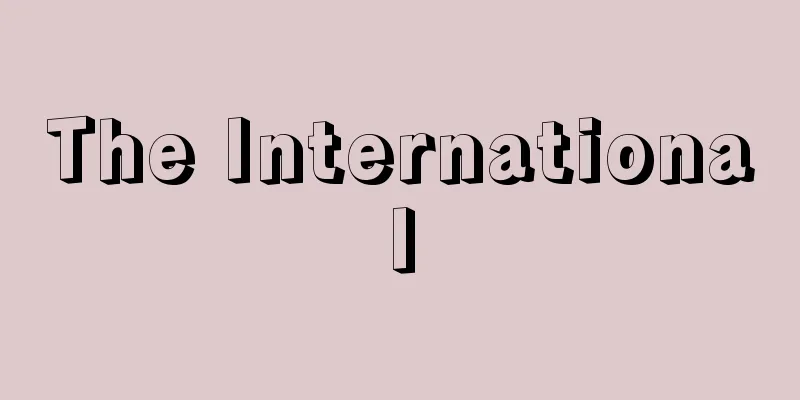The International

|
An international organization of the labor movement based on the socialist ideology of breaking down the capitalist system and liberating workers, and on proletarian internationalism, as symbolized by the slogan "Workers of the world, unite." It is also abbreviated as Inter. Historically, the most representative ones include the First International (International Working People's Association), the Second International, and the Third International (also known as Comintern). Attempts to create a revolutionary international organization were already seen in the Society of the Seasons (founded in 1837) organized by Auguste Blanqui and others, and the Society of Fraternal Democrats (founded in 1846), which was founded by refugees from Germany, Poland, Italy, and other countries and was also involved in the Chartist movement. German refugees and artisans also formed the League of the Just around 1836-1838, which developed into the Communist League in London in 1847 and became the forerunner of the First International. Karl Marx and Friedrich Engels wrote the Communist Manifesto as the platform of the Communist League, which is important in the history of the International in that it provided a theoretical foundation for proletarian internationalism, and it was through this document that the slogan "Workers of the world, unite," which later became the International's slogan, spread around the world. [Tetsuro Kato] First InternationalIts official name is the International Workingmen's Association. The defeat of the European revolutions in 1848-1849 temporarily stagnated the labor movement, but the economic depression of 1858 triggered a resurgence in the labor movement, with labor unions and cooperatives being formed across Europe, and a movement to unite labor movements internationally was also revived. In this context, the International Workingmen's Association was established at an international workers' conference held in London on September 28, 1864. Marx drafted the founding declaration and provisional regulations, which included the "emancipation of labor." In addition to participation at the political organization, labor union, and cooperative level, individual membership was also possible by region. The highest decision-making body was the Congress, which was held in Geneva in 1866, Lausanne in 1867, Brussels in 1868, Basel in 1869, and The Hague in 1872. The executive body was the General Council based in London, with regional branches, and the organizational principle was centralized. The actual number of members is unknown, but it is said to have been around 25,000 in 1866. The peak of activity was the struggle against the Franco-Prussian War (1870-1871) and the solidarity movement during the Paris Commune (1871). Initially, it was made up of various ideological currents (Marxism, trade unionism in England, Proudhonism in Latin countries, Bakuninism/anarchism, and Lassalleism in Germany) that only shared the economic interests of workers, but gradually Marxism became dominant, as seen in the recognition of political struggle at the Lausanne Congress in 1867, the recognition of the common ownership of the means of production and land at the Brussels Congress in 1868, and the resolution to seize political power and form an independent workers' party at the London Congress in 1871. At the Hague Congress in 1872, the conflict between Marxism and Bakunin's anarchism intensified, the Bakuninists were expelled, the seat of the General Council was moved from London to New York, and the First International was effectively dissolved. The Marxists were officially dissolved in Philadelphia in 1876, and the Bakuninists were also unable to maintain the International after the London Congress in 1881. [Tetsuro Kato] Second InternationalThe labor movement, which had stagnated due to the backlash following the Paris Commune, was revived by the economic depression of the latter half of 1880, and labor parties were born in various European countries and the United States, led by the German Socialist Workers Party (founded in 1875). In this environment, momentum for the formation of a new international grew, and on July 14, 1889, at an international congress of socialists from 20 countries that gathered in Paris to commemorate the 100th anniversary of the French Revolution, the Second International was effectively formed. The first congress was held in Brussels in 1891. Unlike the First International, the principle was collective membership of labor parties, labor unions, etc., and individual membership was not accepted. However, there was no principle of centralized organization, and the International Socialist Secretariat was not established in Brussels until 1900, and even then it was merely an administrative and liaison organization. The first period of the Second International's activities, from 1889 to 1904, was a transitional period from the free competition stage of capitalism to monopoly capitalism. The possibilities of workers' representatives' participation in parliament and freedom of the press created conditions for legal activity, while labor aristocrats and union bureaucrats also emerged. In this context, the affiliated parties of the Second International expanded their influence among the masses, and Marxism also became dominant in the labor movement. However, reformism and gradualism, which abandoned the ultimate goal (achievement of socialism) for the immediate benefit of workers, also emerged. This tendency rapidly strengthened after the death of Engels (1895), who had been the greatest leader until then, and in 1898 Bernstein openly advocated revisionism. Although revisionism was condemned in words at the Paris Congress (1900) and the Amsterdam Congress (1904), Kautsky, who was at the forefront of criticism, himself agreed with revisionism in actions. Around 1904, capitalism entered the imperialist stage, and the period of the division of colonies among the great powers and imperialist wars began. The biggest problem for the Second International during this period was the attitude of socialists toward the impending imperialist war, and the Second International split and disintegrated over this issue. At the Stuttgart Congress in 1907 and the Basel Congress in 1912, thanks to the efforts of Lenin and Rosa Luxemburg, a resolution was passed opposing war, and a policy was decided that in the event of war breaking out, the economic and political crisis would be used to overthrow capitalism. However, when the First World War broke out in 1914, the member parties of the Second International, with the exception of a few such as the Bolshevik Party (Russia), shifted to a position of supporting their own governments' imperialist war efforts. Anti-war activists, who were now in the minority, held internationalist conferences in Zimmerwald (Switzerland) in 1915 and Kinthal (Switzerland) in 1916, where they criticized the attitude of the majority and called for an immediate ceasefire. However, even within this minority group, there was a split between the "Left Wing" led by Lenin and others who advocated "transforming the imperialist war into a civil war," and the "Centre" led by Kautsky and Friedrich Adler. The former advocated the formation of a Third International, while the latter called for the revival of the Second International. [Tetsuro Kato] The Second and a Half International and the Socialist Workers' InternationalAfter the Russian Revolution and the end of World War I, social democrats who belonged to the right wing of the old Second International held a preparatory meeting in Bern in February 1919 for the re-establishment of the Second International, and held its first congress in Geneva in 1920. This was called the Bern International. Meanwhile, various centrist parties (such as the French Socialist Party, the British Independent Labour Party, the Independent German Social Democratic Party, and the Austrian Social Democratic Party) also sought to unite internationally and formed the International Socialist Union in Vienna in February 1921. Although it was also called the Vienna International, it was called the Second and a Half International because its platform included the possibility of seizing power by force and the recognition of a proletarian dictatorship, but its attitude toward the Russian Revolution was ambiguous. After the failure of the Berlin Congress of 1922 to unite the Three Internationals ((1) Bern International, (2) Vienna International, (3) Comintern), the Second International (Bern International) and the Second and Half International (Vienna International) united to form the Socialist Workers' International (May 1923). Politically, it inherited the tone of the Second International. The Social Democratic Party of Germany and Austria often participated in the government, but they were unable to initiate socialist transformation and were reluctant to form a united front with the Third International, and they fell apart during the rise of fascism and World War II. Comisco (founded in 1947) and the Socialist International (founded in 1951) after World War II belong to this lineage. [Tetsuro Kato] Third InternationalIts official name was the Communist International, and it was abbreviated as Comintern. Having confirmed the "collapse of the Second International" in World War I and led the Russian Revolution to victory, Lenin issued a call for the convening of the Third International in January 1919 in order to expand and develop this revolution into a world revolution, and at the International Communist Congress held in Moscow from March 2 to 6 of that year, he declared the founding of the Third International. The founding conference was attended by 52 delegates representing 35 organizations from 21 countries, the core of which were the Russian Communist Party (Bolsheviks) and the German Communist Party, which had only been founded at the end of the previous year and initially expressed the view that it was premature to establish the Third International. The activities of the Third International can be roughly divided into three periods: the revolutionary period from 1919 to 1923, the period of relative stability from 1924 to 1928, the Great Depression from 1929 to 1933, the anti-fascist struggle from 1934 to 1938, and the World War II period from 1939 to 1943. Throughout its activities over a quarter of a century, it established communist parties not only in Western Europe but also all over the world, including Asia, Africa and Latin America, spread communist ideology, and nurtured many communist activists. In the early days of Comintern, when Lenin was alive, the goal was to spread the Russian Revolution to the world, and in particular to achieve the success of the German Revolution, but with the restoration of capitalism after World War I and the movement to rebuild the Second International, it was forced to take a detour to ideologically strengthen and popularize the communist parties of each country, and adopted the tactic of a proletarian united front and the establishment of a workers' government (Fourth Congress in 1922). After Lenin's death and the failure of the attempt to establish a workers' government in Germany, the Third International gradually became influenced by the policies of the Communist Party of the Soviet Union, and ideologically, it was deemed binding on the communist parties of each country to "Marxism-Leninism" as interpreted by Stalin, and organizationally, it was deemed binding on the communist parties of each country to "democratic centralism," which was the organizational principle of the Bolshevik Party, and the communist parties of each country were forced to absolutely obey the decisions of the Executive Committee in Moscow as branches of the "Single World Party." For this reason, the political struggle between Stalin and Trotsky over "socialism in one country" in the late 1920s spread to branches in various countries, and the expelled Trotskyists later formed the "Fourth International." Also, during the Great Depression, leftist tactics were adopted in response to the forced construction of "socialism in one country" within the Soviet Union (industrialization, agricultural collectivization, the First Five-Year Plan) (theories of "social fascism," "class against class," and "red trade unionism"), and the united front orientation receded into the background. At its 7th Congress in July-August 1935, it shifted its strategy to a broad anti-fascist united front/popular front, contributing to the establishment of popular front governments in France and Spain, but on the other hand, it became increasingly subordinate to the domestic and foreign affairs of the Soviet Union, ideologically it became increasingly Stalin-worshiping, and organizationally it also took on the role of an external bureau of the Soviet state, and many of the Third International activists in Moscow fell victim to Stalin's purges. With the outbreak of World War II and the establishment of the anti-fascist US-UK-Soviet coalition, the Third International's significance to the Soviet Union declined, and as the Communist parties of each country had also accumulated independent powers, the Third International was dissolved in May 1943 without even holding a congress. After World War II, the Information Office of the Communist and Workers' Parties in Europe (Cominform) was formed in 1947, but was dissolved in 1956 following the "criticism of Stalin." Thereafter, the international communist movement was left to individual negotiations and communication between the various parties, partly due to the rise of independent trends such as Eurocommunism. The international communist movement basically collapsed with the Eastern European Revolution in 1989 and the collapse of the Soviet Union in 1991. Of modern international organizations, the Socialist International, which is a descendant of the Second International, has absorbed former communist forces and organized over 130 political parties around the world, making it the most influential. [Tetsuro Kato] "A History of the Three Internationals" by W.Z. Foster, translated by the International Research Group (1957, Otsuki Shoten)" ▽ "A History of the European Labour Movement" by W. Abendroth, translated by Nomura Osamu (1968, Godo Publishing) ▽ "The Comintern's World View" by Kato Tetsuro (1991, Aoki Shoten) ▽ "A History of the Comintern" by K. McDermatt and J. Agnew, translated by Hagiwara Nao (1998, Otsuki Shoten)" [References] |Source: Shogakukan Encyclopedia Nipponica About Encyclopedia Nipponica Information | Legend |
|
資本主義体制を打破して労働者の解放を図るという社会主義思想と「万国の労働者団結せよ」のスローガンに象徴されるプロレタリア国際主義を基本的理念とした、労働運動の国際組織。インターとも略される。歴史的にみて代表的なものとしては第一インターナショナル(国際労働者協会)、第二インターナショナル、第三インターナショナル(別名、コミンテルン)などがある。 革命的な国際組織をつくる試みは、すでにオーギュスト・ブランキらの組織した季節社(1837年結成)や、ドイツ、ポーランド、イタリアなどからの亡命者によって創設され、チャーティスト運動ともかかわりあった友愛民主主義者協会(1846年結成)にみられる。またドイツの亡命者や職人たちは1836~1838年ごろ正義者同盟を結成したが、これは1847年ロンドンで共産主義者同盟へと発展し、第一インターナショナルの前身となった。カール・マルクスとフリードリヒ・エンゲルスは共産主義者同盟の綱領として『共産党宣言』を執筆したが、これはプロレタリア国際主義を理論的に基礎づけた点でインターナショナルの歴史にとって重要なもので、のちにインターナショナルのスローガンとなった「万国の労働者団結せよ」はこの文書によって世界に広がった。 [加藤哲郎] 第一インターナショナル正式名称は国際労働者協会という。1848~1849年のヨーロッパの革命の敗北は労働運動を一時沈滞させたが、1858年の経済恐慌を契機にして労働運動はふたたび活発になり、全ヨーロッパ規模で労働組合や協同組合が結成され、それに伴って労働運動を国際的に結合させる動きもよみがえった。こうした流れのなかで、1864年9月28日ロンドンで開かれた労働者の国際会議で、国際労働者協会が設立された。マルクスが創立宣言、暫定規約などの起草にあたり、そのなかには「労働の解放」が書き込まれた。政治団体、労働組合、協同組合レベルでの参加だけでなく、地域別の個人加盟も行われた。最高決定機関は大会で、1866年ジュネーブ、1867年ローザンヌ、1868年ブリュッセル、1869年バーゼル、1872年ハーグで開かれた。執行機関はロンドンに拠を置く総評議会で、地域ごとに支部がつくられ、組織原則は中央集権的であった。加盟人数の実数は不明だが、1866年で2万5000人ほどといわれる。活動のピークは、プロイセン・フランス戦争(1870~1871)に対する闘いとパリ・コミューン(1871)における連帯運動であった。当初は、労働者の経済利害に共通基盤を置くだけのさまざまなイデオロギー的潮流(マルクス主義、イギリスの労働組合主義、ラテン系諸国のプルードン主義、バクーニン主義=無政府主義、ドイツのラッサール主義)からなっていたが、1867年のローザンヌ大会における政治闘争の承認、1868年のブリュッセル大会での生産手段や土地の共有化の承認、1871年のロンドン会議における政治権力の奪取や独自の労働者政党の結成の決議などにみられるように、しだいにマルクス主義が支配的となった。1872年のハーグ大会では、マルクス主義とバクーニンの無政府主義の対立が激化し、バクーニン派は追放され、総評議会の所在地もロンドンからニューヨークに移され、第一インターナショナルは事実上解体した。マルクス派の正式の解散宣言は1876年にフィラデルフィアで行われ、バクーニン派も1881年のロンドン大会以降インターナショナルの維持が不可能となった。 [加藤哲郎] 第二インターナショナルパリ・コミューン後の反動によって停滞していた労働運動も、1880年後半の経済恐慌でふたたび復活し、ドイツ社会主義労働者党(1875年結成)を筆頭にヨーロッパ各国とアメリカに労働者政党が誕生した。こうしたなかで新しいインターナショナルを結成する気運も盛り上がり、89年7月14日、フランス革命100周年を記念して20か国からパリに集まった社会主義者の国際大会で、第二インターナショナルが事実上結成された。第1回大会は91年ブリュッセルで開かれた。第一インターナショナルとは異なって、労働者政党や労働組合などの集団加盟が原則で、個人加盟は行われなかった。しかし中央集権的組織原則はなく、国際社会主義事務局がブリュッセルに設置されたのが1900年になってからのことであり、それも事務連絡機関といった性格のものであった。第二インターナショナルの活動の第一期といわれる1889~1904年は、資本主義の自由競争的段階から独占資本主義への移行期にあたり、労働者代表の議会参加や出版の自由などの可能性によって合法的活動の条件が生まれる一方、労働貴族や組合官僚も出現した。こうした背景のなかで第二インターナショナル加盟政党は大衆の間で影響力を拡大し、マルクス主義も労働運動のなかで支配的なものとなったが、労働者の目前の利益のために最終目標(社会主義の達成)を放棄した改良主義、漸進主義も発生した。この傾向は、それまでの最大の指導者エンゲルスの死(1895)後急速に強まり、1898年にベルンシュタインが修正主義を公然と主張した。パリ大会(1900)、アムステルダム大会(1904)では、この修正主義が「ことばのうえ」では非難されたものの、批判の先頭にたったカウツキー自身も「行動のうえ」では修正主義に同調していった。 1904年前後から資本主義は帝国主義段階に突入し、列強間の植民地分割と帝国主義戦争の時期に入るが、この期の第二インターナショナルにとって最大の問題は、迫りくる帝国主義戦争に対する社会主義者の態度の問題であり、これをめぐって第二インターナショナルは分裂・解体していった。1907年のシュトゥットガルト大会、1912年のバーゼル大会では、レーニンやローザ・ルクセンブルクの努力でいちおう戦争反対の決議を行い、戦争勃発(ぼっぱつ)の場合には経済的・政治的危機を資本主義打倒のために利用するという方針を決めた。だが1914年に第一次世界大戦が勃発すると、第二インターナショナル加盟政党は、ボリシェビキ党(ロシア)など一部を除いて、自国政府の帝国主義戦争遂行を支持する立場に回った。少数派となった反戦主義者は、1915年ツィンメルワルト(スイス)と1916年キンタール(スイス)で国際主義者大会を開き、多数派の態度を非難、即時停戦を訴えた。だがこの少数派の内部でも、レーニンらに率いられ「帝国主義戦争の内乱への転化」を唱えた「左派」と、カウツキーやフリードリヒ・アドラーらに率いられた「中央派」に分裂していた。前者は第三インターナショナルの結成を主張、後者は第二インターナショナルの復活を唱えた。 [加藤哲郎] 第二半インターナショナルと社会主義労働者インターナショナルロシア革命と第一次大戦終結の後、旧第二インターナショナルの右派に属していた社会民主主義者は、1919年2月ベルンに再建のための準備会を開き、1920年にはジュネーブで第1回大会をもった。これはベルン・インターナショナルとよばれる。一方、中央派に属する諸政党(フランス社会党、イギリス独立労働党、ドイツ独立社会民主党、オーストリア社会民主党など)も、その国際的結集を図って1921年2月ウィーンにおいて国際社会党同盟を結成した。ウィーン・インターともいうが、武力による政権奪取の可能性やプロレタリア独裁の承認などを綱領に盛り込みながら、ロシア革命への態度はあいまいであったため、第二半インターナショナルとよばれた。 1922年にベルリンでの三つのインターナショナル((1)ベルン・インター、(2)ウィーン・インター、(3)コミンテルン)の統一のための国際会議が失敗したのち、第二インターナショナル(ベルン・インター)と第二半インターナショナル(ウィーン・インター)は統一して社会主義労働者インターナショナルを結成した(1923年5月)。政治的には第二インターナショナルの基調を受け継いだ。ドイツやオーストリアの社会民主党はしばしば政権にも参加したが、社会主義的変革に着手することはできず、第三インターナショナルとの統一戦線には消極的で、ファシズムの台頭と第二次大戦のなかで解体していった。第二次大戦後のコミスコ(1947年結成)、社会主義インターナショナル(1951年結成)は、この系譜に属する。 [加藤哲郎] 第三インターナショナル正式名称は共産主義インターナショナルで、コミンテルンの略称が用いられた。第一次大戦での「第二インターナショナルの崩壊」を確認しロシア革命を勝利させたレーニンは、この革命を世界革命へと拡大・発展させてゆくために、1919年1月、第三インターナショナル招集の檄(げき)を発し、同年3月2~6日モスクワで開かれた国際共産主義者会議で、第三インターナショナル創立を宣言した。創立会議には、21か国35の組織を代表する52名の代表が出席したが、その中心は、ロシア共産党(ボリシェビキ)と、前年末に結党したばかりで第三インター創設には当初時期尚早の見解を示していたドイツ共産党であった。第三インターナショナルの活動は、1919~1923年の革命的情勢期、1924~1928年の相対的安定期、1929~1933年の大恐慌期、1934~1938年の反ファッショ闘争期、1939~1943年の第二次大戦期に大まかに区分されるが、その四半世紀の活動を通じて、西欧諸国にとどまらず、アジア、アフリカ、ラテンアメリカを含む全世界に共産主義政党を結成し、共産主義の思想を普及させ、多くの共産主義活動家を育成した。 レーニンが存命した初期のコミンテルンは、ロシア革命を世界に拡大することを目標とし、とりわけドイツ革命の成功を目ざしていたが、第一次大戦後の資本主義の復興と第二インター再建の動きのなかで、ひとまず各国共産党の思想的強化と大衆化の迂回(うかい)をとることを余儀なくされ、プロレタリア統一戦線と労働者政府樹立の戦術が採用された(1922年第4回大会)。レーニンの死とドイツでの労働者政府樹立の試みの失敗ののち、第三インターは、しだいにソ連共産党の政策に左右されるようになり、イデオロギー的にはスターリンによって解釈された「マルクス・レーニン主義」、組織的にはボリシェビキ党の組織原則であった「民主集中制」が各国共産党を拘束するものとされ、各国共産党は「単一世界党」の支部としてモスクワの執行委員会の決定への絶対服従を強いられていった。このため、1920年代後半のスターリンとトロツキーの「一国社会主義」などをめぐる政争は各国支部にも波及し、除名されたトロツキー派はのちに「第四インター」を結成していった。また、大恐慌期には、ソ連邦内での「一国社会主義建設」の強行(工業化と農業集団化、第一次五か年計画)に照応した左翼主義的戦術が採用され(「社会ファシズム」論、「階級対階級」論、「赤色労働組合」主義)、統一戦線的志向は後景に退いた。1935年7~8月の第7回大会で、反ファシズムの広範な統一戦線・人民戦線へとその戦略を転換させ、フランスやスペインの人民戦線政府樹立に貢献したが、その反面、ソ連邦の内政外交にますます従属し、イデオロギー的にはスターリン崇拝が強まり、組織的にはソ連邦国家の外局的役割をも担うこととなり、モスクワにいた第三インター活動家の多くもスターリン粛清の犠牲となった。第二次大戦勃発と反ファシズム米英ソ連合の成立により、第三インターのソ連にとっての意義は減退し、各国共産党も自主的力量を蓄えてきたため、1943年5月、第三インターは大会も開くことなく解散された。第二次大戦後、1947年にヨーロッパ共産党・労働者党情報局(コミンフォルム)が結成されたが、「スターリン批判」に伴い1956年に解散され、以後の国際共産主義運動は、ユーロコミュニズムなど自主的な潮流の台頭もあって、各党間の個別的交渉・連絡にゆだねられた。 1989年の東欧革命と1991年ソ連解体によって、国際共産主義運動は基本的に崩壊した。現代のインターナショナル組織としては、第二インターの系譜を引く社会主義インターナショナルが、旧共産主義勢力をも吸収して世界で130以上の政党を組織し、もっとも有力なものとなった。 [加藤哲郎] 『W・Z・フォスター著、インタナショナル研究会訳『三つのインターナショナルの歴史』(1957・大月書店)』▽『W・アーベントロート著、野村修訳『ヨーロッパ労働運動史』(1968・合同出版)』▽『加藤哲郎著『コミンテルンの世界像』(1991・青木書店)』▽『K・マクダーマット、J・アグニュー著、萩原直訳『コミンテルン史』(1998・大月書店)』 [参照項目] |出典 小学館 日本大百科全書(ニッポニカ)日本大百科全書(ニッポニカ)について 情報 | 凡例 |
<<: International Harvester Co.
Recommend
Aniruddha
…Even though there were only five teachers in the...
Cartesian coordinates
Please see the "Cartesian coordinates" ...
Okikumushi - Okikumushi
It refers to the pupa of the Chinese Thymus, a me...
White-tailed deer
It is an animal of the Cervidae family of the ord...
October Revolution
The revolution that marked the climax of the Russi...
Umeboshi candy - Umeboshi candy
…Today, sugar is mixed with starch syrup and wate...
Temari - Temari
A ball used in ball games, or a game of balls pla...
Izawa Iekage
Year of death: Kenpo 3.3.12 (1215.4.12) Year of bi...
Lauric acid - Laurinsan (English spelling) lauric acid
A saturated fatty acid. Also known as dodecanoic ...
Best, CH (English spelling) BestCH
…It acts on the liver, muscles, and fat tissues, ...
Nonwoven fabric - Fushokfu
It is a cloth-like material in which staples or f...
Temporary Headquarters - Karihonjin
…Honjin was a camp where a general was stationed ...
Schiffornis
…All species are small birds, smaller than the gr...
Mitamura Engyo - Mitamura Engyo
A researcher of the Edo period. Born in Hachioji,...
Fruit bat (Fruit bat)
A general term for mammals belonging to the order ...



![Minamikushiyama [town] - Minamikushiyama](/upload/images/67ccf3eeaa7c2.webp)





